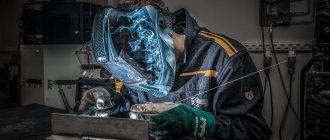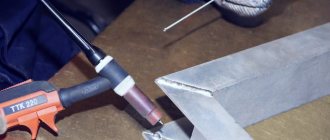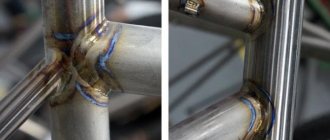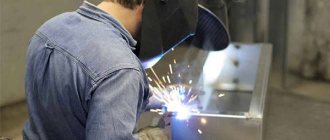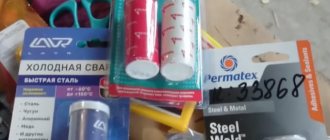12/27/2019 Author: VT-METALL
Issues discussed in the material:
- Why is argon suitable for welding aluminum?
- Preparatory procedures before welding aluminum with argon
- Aluminum argon welding technology
- How to check the quality of aluminum argon welding
Argon welding of aluminum is the only way to obtain a strong connection that meets all the requirements. The problem with welding aluminum is that on its surface there is an inert oxide film that is strong enough to render other welding methods ineffective.
However, it is not enough to simply choose argon welding as a method. It is also necessary to select the right consumables and configure the equipment itself. Read our article about how to get strong seams that do not require processing, what are the ways to check connections.
Why is argon suitable for welding aluminum?
Any inert gas is suitable for working with metals such as aluminum. An example is helium; it was used back in the 40s of the 20th century in the United States of America as a gas for welding aluminum and its alloys. But argon has one undeniable advantage - its cost is much lower while maintaining the same result. However, the work requires different knowledge - why high-quality seams connecting aluminum parts are created under a protective layer of inert gas.
Scrape the surface of any aluminum product and you will see shiny metal. However, gradually the shine of the metal will become cloudy and become duller. This indicates the ongoing process of aluminum oxidation. Which scientifically sounds like “the formation of aluminum oxide (Al2O3)” - a substance that appears on the surface to protect the metal from continued oxidation.
Pure aluminum has a melting point of +6600 °C, and the film covering its surface is +20,000 °C. This makes conventional welding very difficult. We have to look for a technology that will first remove the oxidized layer from the surface and remove it from the welding zone. And she is. The main source of energy for it is electricity, which creates an alternating current arc. The direction of the latter changes in the same way as the current in a conventional electrical network with a frequency of 50 Hz.
When working with aluminum, alternating current solves several problems:
- Makes it possible to use light, compact equipment (inverters for welding), replacing with them huge converters, which, in addition to their size, were inconvenient due to the need for special preparation of the welding site and increased requirements for the qualifications of a specialist.
- Easily removes a layer of aluminum oxide from the metal surface, since the operating temperature of the electrode is higher than the thermal resistance of Al2O3.
While performing work, it is necessary to strictly maintain the polarity of the electric current. Reverse polarity, where the electrode becomes the anode, is a process in which the electron flow goes as follows: electrode → workpiece. Inside the arc, the temperature ranges from +5,000 °C to +6,000 °C, which is higher than the temperature of the contact zones, but it is still significantly higher than the melting point of aluminum. Electrons with their energy tear the aluminum oxide film and clean it from the metal surface, ensuring high-quality smelting.
We recommend articles on metalworking
- Steel grades: classification and interpretation
- Aluminum grades and areas of their application
- Defects in metal products: causes and search methods
However, reverse polarity alone is not enough to perform welding work with aluminum. The environment must be neutral to high temperatures and protect the surface from newly formed oxide. Which is what an inert gas does.
Argon welding of aluminum has high productivity and makes the process stable, ensuring the required quality of the weld on the product.
Preparatory procedures before welding aluminum with argon
Working with aluminum has many features that must be taken into account during the welding process:
- Rapid coating of a metal surface with an oxide film as a result of interaction with oxygen in the air around us due to high chemical activity. The melting point of the film is > +2,000 °C, while the metal itself melts at +660 °C. If hard parts of the film get into the weld, the quality and strength of the latter are significantly reduced.
- Control of the argon welding process of aluminum is difficult, since the color of the metal does not change during melting.
- As a result of its hygroscopicity, aluminum absorbs moisture from the air. Subsequently, when heated, it begins to evaporate and interferes with the welding process due to argon, deteriorating the quality of the seam.
- Aluminum has a high coefficient of linear expansion. Therefore, during cooling, the workpiece may become quite deformed or crack. To avoid this, when welding with argon, the consumption of filler wire is increased or the seam is modified.
The argon consumption during welding must be carefully adjusted. If there is insufficient supply of aluminum to the work area, aluminum may foam, but an excess will not allow making a correct seam.
One type of equipment should be an AC argon aluminum welding machine. The DC setting is not suitable for argon welding. The most suitable may be an inverter with TIG mode. Additional options in it should allow:
- ignition of the arc using a non-contact method;
- AC balance regulation;
- welding the weld crater with argon;
- regulation of the argon supply time after the arc is turned off.
To reduce argon consumption during aluminum welding, it is necessary to replace a conventional torch with one equipped with a gas lens, which is also called a collet holder. There is a special mesh inside this device. Argon passes through its cells, which reduces consumption while increasing protection of the welding site.
How can you reduce consumption?
The main indicator in the welding process is the quality and reliability of the seam. For this purpose, in fact, shielding gas is used. Therefore, it makes little sense to artificially reduce the consumption of welding mixtures, as this can lead to the formation of pores and other side effects.
Defective seam, low-quality welding mixture used
The quality indicators of the gas itself also play an important role. For example, when using the multi-component composition “Mixpro 3212”, consumption is reduced by at least two times, compared with the use of binary protective gases based on argon and carbon dioxide. In addition, in the case of Mixpro, the quality of the seam will be much higher.
By the way, you will find more information about welding mixtures in this section of the blog.
Aluminum argon welding technology
One of the serious stages of argon welding is cleaning the edges of parts. Before starting work, you need to mechanically clean them and then degrease them. To remove all fats from the surface of parts, you need to use a solvent, for example, acetone. In addition, when the thickness of the part is > 0.4 cm, it is sometimes necessary to cut the edges, that is, to bevel them. This is done to lower the weld pool below the surface level of the part in order to form the root of the weld.
To avoid burns, a small dullness is left. When processing thin workpieces with argon, flanging is used - this is the name given to the process of bending the edges of parts at right angles. This is done to ensure a tighter fit of the parts to each other during argon welding. If the edges are well prepared, the stress on the workpiece will be removed and its deformation will not occur, which will increase the quality of the welded joint.
The oxide film must be removed from the surface. To do this, the edges of the parts are treated with any abrasive (for example, sandpaper) at a distance of ≤ 3 cm from the edge. You can also use a file.
VT-metall offers services:
Heat is dissipated well if the workpiece is placed on a steel or copper pad. Thin workpieces must be placed in such a way as to prevent the formation of burns from the argon connection.
After completing the preparatory work, you need to properly adjust the alternating current, select the correct electrode, select its diameter and filler wire for argon connection. The information below is intended to facilitate the selection process. When using a dual-mode device, it must be switched to AC operating mode.
Table:
| Seam formation method | Current strength, A | Workpiece thickness, mm | Electrode diameter, mm | Wire diameter, mm |
| With beaded edges | 45–50 | 1,0 | 1,0 | — |
| 70–75 | 1,5 | 1,6–2,0 | — | |
| 80–85 | 2,0 | 1,6–2,0 | — | |
| Butt joint, single sided | 55–75 | 2,0 | 1,5–2,0 | 1,0–2,0 |
| 100–120 | 3,0 | 3,0–4,0 | 2,0–3,0 | |
| 120–150 | 4,0 | 3,0–4,0 | 2,0–3,0 | |
| Butt joint, double sided | 120–180 | 4,0 | 3,0–4,0 | 3,0–4,0 |
| 200–250 | 5,0 | 4,0–5,0 | 3,0–4,0 | |
| 240–270 | 6,0 | 4,0–5,0 | 3,0–4,0 |
Work begins with high current to quickly heat up the metal. During the process, the current decreases, which prevents subsequent burnouts, since the heat quickly spreads throughout the argon welding zone.
Setting the rate of argon supply to the weld pool is very important. The intensity is strongly influenced by the current and the speed of the torch. Let's look at a few examples: an aluminum sheet 0.1 cm thick is processed with a current < 50 A - the argon flow rate will be from 4 to 5 l/min. With a thickness of 0.4–0.5 cm and a current > 150 A, the argon flow rate will increase to 8–10 l/min. An excessive amount of argon in the weld pool can lead to air impurities, and this will worsen the performance of the weld. If it is deficient, the seam cannot be effectively protected from exposure to oxygen.
Calculation of welding mixture consumption
There is a formula that allows you to find out the approximate consumption of the welding mixture during the welding process:
P = Ru x T
where, Ru – specific gas consumption declared by the manufacturer,
T is the main time spent on welding one pass.
The specific consumption of shielding gas depending on the wire diameter at average current values can be seen below:
- 1.0 mm – 9 l/min;
- 1.2 mm – 12 l/min;
- 1.4 mm – 15 l/min;
- 1.6 mm – 18 l/min;
- 2.0 mm – 20 l/min.
Table 1 depending on the parameters
Table 2 depending on the parameters
Based on the fact that a standard 40-liter cylinder contains 6 m³ or 6000 liters of welding mixture, you can easily calculate how long one tank will last during a continuous welding process.
For example, when using a wire with a diameter of 1 mm and combining argon with carbon dioxide, a 40 liter cylinder will be completely empty after 10-11 hours of continuous process.
Naturally, such calculations are quite rough, since they do not take into account gas consumption for preparatory and finishing operations during one pass. However, they allow you to see an approximate picture. When using flow meters and verifying readings, these calculations will be more accurate and objective.
Checking the quality of aluminum argon welding
Products and structures made of aluminum and its alloys are used in mechanical engineering. These are pipelines, tanks, containers, etc. Their reliability and durability are determined by the quality of the welds.
The main methods for monitoring welded joints of aluminum products are ultrasonic flaw detection, X-ray and gamma graphing, visual inspection and measurement, and hydraulic testing with a helium leak detector.
The mechanical properties of welds created with argon must be checked, metallography is carried out - checking the composition and structure of the joint (in the case of performing work that technologically involves thermal control of welding with argon).
The inspection is entrusted to the quality control department employees of the manufacturer of aluminum structures; sometimes the inspection is carried out with the participation of representatives of the customer, since argon welding of aluminum, the price of which is not considered high, is at the same time very responsible.
Methods, parameters and scope of control work are established for each group of products, type of design, and sometimes for specific products, in accordance with the “Control Rules” or technical specifications.
There are certain features in the inspection of products made of aluminum and its alloys, since the material is prone to the formation of pores inside the connection made with argon. In addition to pores, non-fusion can also form in the seam, occurring between the edges and the seam, as well as between the rollers. Searches for non-fusions are difficult because they cannot be detected by X-ray and gamma graphs. Specialists use ultrasound for this purpose when performing flaw detection.
Lack of fusion at the root of the weld is a fairly common defect that occurs when working with a non-consumable electrode during through fusion, when the root of the weld is created on a non-remaining lining. The root of the weld, if it is impossible to gain access to the weld, should be done under the protection of neutral gas. And immediately before welding with argon, it is necessary to scrape the edges to remove the oxide film.
When carrying out multi-layer metal processing, the pores in the lower layers can melt during the process of applying the upper rollers! That is why porosity is not taken into account during the intermediate X-raying of the product.
All welded joints undergo a control procedure for external inspection, except for seams that have external defects - sagging, fistulas at the beginning of the seam, cracks, craters that have not undergone welding and their leads to the base metal, chains of pores and solid meshes, lack of fusion and undercuts.


